
2024 commencement. Back (L to R): Julian Bieber-Dishart, Marisa Denkinger, Katie Cording, Jacob Ziontz. Front: Xue Lily Gong, Hayley Bounds, Erin Aisenberg, Madeline Klinger, Professor Frédéric Theunissen. Photo by GradImages
Congratulations to our recent and upcoming Neuroscience PhD Program graduates: Matthew Davis, Erin Aisenberg, Katie Cording, Marisa Denkinger, Julian Bieber-Dishart, Xue Lily Gong, Madeline Klinger, Sylvia Madhow, Hayley Bounds, and Jacob Ziontz!
Read our Q&A below with some of the graduates to learn about their most interesting discoveries, future plans, and words of advice.
Erin Aisenberg, Bateup lab

Thesis: Elucidating a Novel Peptidergic Circuit in the Nucleus Accumbens Medial Shell
What is the most interesting thing you discovered in your research here?
When I set out on my project I was interested in looking at the role of GRP-GRPR (gastrin-releasing peptide-GRP receptor) signaling in the nucleus accumbens medial shell. However, as I was doing so, I discovered that the receptor-expressing cells represented a novel subpopulation of striatal projection neurons that had previously never been classified with unique electrophysiological properties.
What are you doing next?
I will be staying on as a postdoc in the Bateup lab to finish my paper.
Do you have any advice for incoming or current students?
There is always going to be more to do, so make sure to set boundaries and take time away from the lab. Also, you will fail a lot during your PhD, so try not to be too hard on yourself.
Julian Bieber-Dishart, Dillin lab
Thesis: Olfaction regulates peripheral mitophagy and mitochondrial function 
What is the most interesting thing you discovered in your research here?
We were fascinated to learn that the olfactory nervous system instructs peripheral tissues to perform mitophagy, limiting mitochondrial iron stores from invading pathogens, and conferring a pathogen resistance phenotype. Altogether, our research shows that the olfactory nervous system evolved to anticipate pathogenic infection, and prime the organism to withstand pathogenic insult.
What are you doing next?
I'll be venturing into the intellectual property law field.
Do you have any advice for incoming or current students?
Take advantage of the wide world of UC Berkeley! Explore classes outside of neuroscience and in other schools, and attend career panels. You never know what might interest you.
Hayley Bounds, Adesnik lab 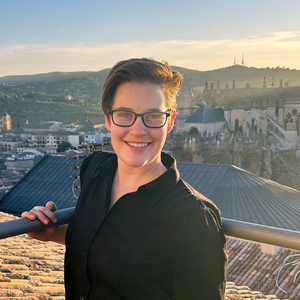
Thesis: Causally Connecting Cortical Codes to Visual Perception
What is the most interesting thing you discovered in your research here?
I used new 2-photon optogenetics to target and activate individual neurons in the brain while mice performed a visual task. I learned that the neurons that we thought would be the most involved in allowing mice to detect hard to see stimuli, that is, the neurons that respond strongly to that stimulus, were no more involved than any other neuron was.
What are you doing next?
I'll be starting my postdoc in the Losonczy Lab at Columbia, studying place coding in the hippocampus.
Do you have any advice for incoming or current students?
Make sure you really care about answering the questions your project(s) are asking — you're going to be working on them for a long time, even if it's only a subproject, and without that drive it's hard to stay motivated.
Katie Cording, Bateup lab
Thesis: The impact of autism spectrum disorder risk gene mutations on striatal circuit function
What is the most interesting thing you discovered in your research here?
In my research I studied two different genetic mouse models of autism spectrum disorder. Despite having different genetic mutations and physiological changes, both models exhibited the same overall circuit change in a subregion of the striatum, a subcortical region involved in action selection and motor learning. Both models also exhibited increased performance in a motor learning task. It was very cool to find that convergence of circuit and behavior change arising from different genetic manipulations.
What are you doing next?
I'll be finishing up my project as a postdoc in the Bateup lab, and then I'll likely pursue research in industry.
Do you have any advice for incoming or current students?
Try to remember and find the joy and excitement of research when things are tough. We're pursuing knowledge for knowledge's sake, and that's really cool! I think sometimes this means not taking things too seriously, learning how to walk away and take a breather when something isn't working, and having hobbies, passions and friends outside of lab that keep you refreshed and ready to get back into work the next day.
Marisa Denkinger, Jagust lab
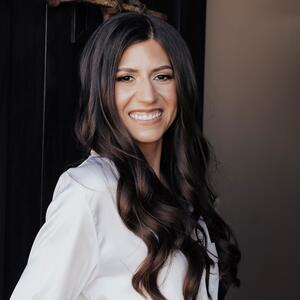
Photo Credit: Erin Marie Photos
Thesis: Relationships between blood-brain barrier disruption and Alzheimer's disease biomarkers in aging
What is the most interesting thing you discovered in your research here?
My research used multimodal neuroimaging methods to investigate whether there is a relationship between neurovascular dysfunction, in particular blood-brain barrier disruption, Alzheimer's disease (AD) biomarkers, and cognition during normal aging. The most interesting discovery from my dissertation was that blood-brain barrier disruption selectively affects memory performance, and this impact depends on the extent of atrophy observed. Importantly, this relationship does not depend on global amyloid beta and regional tau levels. These results suggest that in normal aging, where there may not be substantial AD pathology, having greater blood-brain barrier disruption and atrophy may have an impact on memory performance.
What are you doing next?
I am currently exploring options for postdoctoral fellowships, focused on aging and Alzheimer's disease in Phoenix, Arizona.
Do you have any advice for incoming or current students?
My advice for incoming students is to prioritize a healthy work-life balance. Getting a PhD is a long road and it is super important to take care of yourself, so that you can achieve your research goals!
Xue Lily Gong, Theunissen and Gallant labs
Thesis: Language representation in human cerebral cortex
What is the most interesting thing you discovered in your research here? 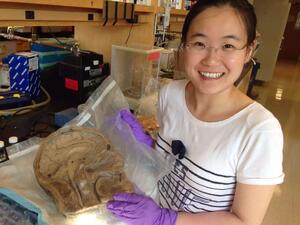
Brain representation of language is far more "messy" than I initially anticipated. Rather than being neatly organized to specific cortical regions, it involves complex and simultaneous representing and integrating of multiple levels of information.
What are you doing next?
Postdoc in UCSF.
Do you have any advice for incoming or current students?
When selecting a lab to join during my first year, I followed advice that prioritized Professor > People > Project. I believe this is also applicable to my PhD journey. I chose professors whom I admire and see as my mentors, someone I want to become. I surrounded myself with colleagues, aiming to build lifelong friendships and collaborations. The project I ended up working with has grown into a topic that motivates my future research.
To me, the PhD journey is inherently nonlinear and highly personalized, presenting unique challenges to each one. My experience in the Neuroscience PhD Program taught me the importance of seeking help when needed. The community here is incredibly supportive, always ready to assist in any aspect of both academic and personal challenges.
My PhD did not start as I had envisioned; it was filled with unexpected twists that were truly mind-blowing. However, it concluded much better than I expected, which was a pleasant surprise, though I believe I would have been happy regardless. This experience has made me more resilient and mature in all aspects. I sincerely hope all of you will have a fulfilling journey in the Neuroscience PhD Program.
Madeline Klinger (she/her), Wilbrecht and Landry labs
Thesis: Fluorescent Adolescence: Shedding Light on Neural Encoding of Task Information in the Adolescent vs. Adult Frontal Cortex
What is the most interesting thing you discovered in your research here? 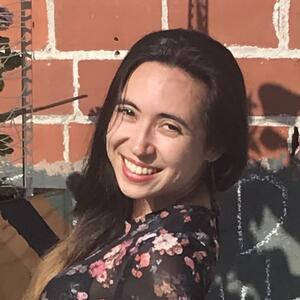
Adolescent mice are actually quite good at an inhibitory control task, despite pop science maligning adolescents as "impulsive". In the case of my task, being a little "impulsive" actually seemed to help adolescents better sample and understand their environment, and they learned faster than adults. Neurons in layer 2/3 of the adolescent dorsomedial prefrontal cortex (dmPFC) also contained more decodable information about task variables than the adult dmPFC.
What are you doing next?
Catching up on artistic endeavors I've put on hold, while also applying for positions as a program manager or program officer at funding institutions. My career goal is to help guide neuroscience toward a more equitable research practice.
Do you have any advice for incoming or current students?
Figure out your work style and what you need from a mentor to succeed. Come up with agreements and clear expectations between yourself, your mentor, and your lab. Be proactive about asking for help and meetings. Advocate for your needs, and prioritize your mental health!
Sylvia Madhow, Bouchard lab
Thesis: Parsimonious estimates of functional connectivity and biomarkers of cognitive development in early childhood
What is the most interesting thing you discovered in your research here? 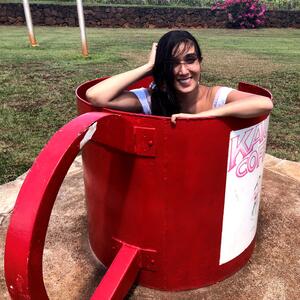
My work was in predictive modeling of cognition and behavior from brain data. I found that modeling temporal dependence in brain activity produces sparse and graphically efficient connectomes, but that we still have a long way to go before our approach can accurately and consistently predict cognitive development. Above all, I gained new appreciation for the importance of interpretability in predictive modeling — all the accuracy in the world is of little consequence without a deep understanding of the underlying data. Also, always sing to your rats — they don't criticize even when you're flat.
What are you doing next?
If the past few weeks are any indication, I'll be sketching a lot, muttering to myself, and dipping my toes in the ocean.
Do you have any advice for incoming or current students?
It's so easy to get impatient with yourself and become preoccupied with perceived shortcomings. Give yourself the time and grace to learn.
Jacob Ziontz, Jagust lab
Thesis: Functional networks in aging and Alzheimer's disease: Contributions and consequences
What is the most interesting thing you discovered in your research here? 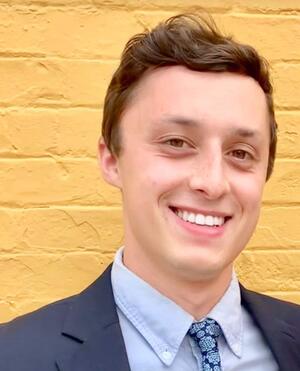
In the aging brain, how strongly connected different regions are is closely associated with the spread of neuropathology between these regions. This represents not only a potential way to predict where and how quickly pathology will spread, but also how the connectivity profile of different brains may influence the specific cognitive deficits that individuals experience as they age.
What are you doing next?
I'm starting a postdoc at UCSF with Drs. Renaud La Joie and Gil Rabinovici studying clinical dementia phenotypes, distribution of Alzheimer's tau pathology, and brain connectivity.
Do you have any advice for incoming or current students?
One of the most critical parts of your PhD training is learning how to think like a scientist. While you build research skills and collect data, don't forget that thinking about science is important and hard work and you should reward yourself for doing it!
—

